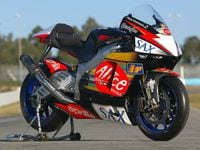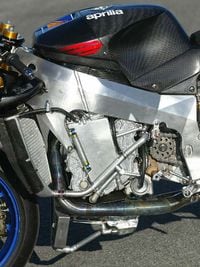Sometimes you're not sure afterward if it was such a good idea to say, "Yes." But when Aprilia president Ivano Beggio generously arranged an exclusive test at the Spanish Jerez circuit of his company's RS3 Cube three-cylinder pneumatic-valve MotoGP contender, I said "Yes, please!" before he could change his mind--and then sat back and started wondering if I'd done the right thing!
I mean, this is the motorcycle which no less than former World Superbike Champion Colin Edwards proclaimed was "born bad," which has "just so many things that need fixing," including its appetite for wheelies, lack of front-end feel, chatter at both ends, and an unpredictable response from its fly-by-wire throttle. His teammate on the 2003 works Aprilia team, Nori Haga, crashed the Cube no less than 28 times in a single season.
First, some background. Unveiled at the Bologna Motor Show in December 2001 by Beggio and Aprilia's race boss Jan Witteveen, the RS3 (aka Cube) dohc three-cylinder in-line 990cc engine was developed in conjunction with longtime British engine specialist Cosworth starting in September 2000. Cosworth also had previously assisted Aprilia with R&D; of its RSV1000SP V-twin Superbike. But it was Cosworth's experience in developing a series of Formula 1 racing car engines down the years, culminating in the current pneumatic-valve Jaguar V-10 race motor, which led Witteveen to work with the firm again in producing Aprilia's first four-stroke GP contender.
"We chose a three-cylinder engine for several reasons," says 56-year old Witteveen, with Aprilia since 1989 and architect of the company's 13 world titles in the past decade. "The first was that I was sure the Japanese wouldn't make a triple, and it was important for Aprilia to have something different from the others. The MotoGP rules favor three- and five-cylinder machines, and historically, the triple is more a European concept. And our motorcycle blends all the established knowledge we've acquired in both Superbike and Grand Prix racing in recent years, employing typical European engine technology.
"The second reason for choosing the three is we wanted to use the benefits of Formula 1 technology in developing an anything-goes high-tech power unit, and a 990cc triple has a 330cc cylinder capacity, which is very close to the dimensions of a 10-cylinder 3.5-liter F1 car. This way, I could use a lot of technology and parts from Formula 1, which would save [some development] time.
"A third reason is that from a production point of view, a three-cylinder engine is the cheapest to reproduce when we come to develop a street-legal replica, or even a Superbike, later on.
"We didn't need pneumatic valves to begin with," admits Witteveen, "but I wanted to have the system in place for when it did become necessary, as we raised the rev ceiling in search of more power. We have lots of potential locked up in the engine, and it now pulls from very low, between 7000 to 11,000 rpm, so it's quite rideable, now." Official power figure for the Aprilia in its end-of-'03 guise is a coy "over 220 bhp" at the gearbox, but the Cube's top speeds at certain race tracks suggests a figure closer to 240 bhp.
The Cube's 120-degree crankshaft with evenly spaced throws features a balance shaft mounted between it and the clutch to reduce vibration, which means the crank runs backward on the Aprilia, as on the Yamaha M1. "It rotates in the opposite direction to the wheels of the bike, which gives an improved gyroscopic effect resulting in more stability in high-speed corners, and doesn't affect it too badly in low-speed ones," explains Witteveen. "The inertia of the balance shaft is much less than the crankshaft, so it's an overall benefit." The 6-3-1 Akrapovic exhaust system features twin-port headers exiting each of the three cylinders, all merging into a single, large-diameter exhaust.
Aprilia developed its own electronic engine management package for the Cube, housed in the ultra-compact ECU incorporated in the back of the instrument panel. It controls not only the ignition and Aprilia's proprietary fuel injection, but also the F1-type ride-by-wire electronic throttle control. "We have the option whether to activate this or not," says Witteveen, "but after a lot of work understanding how to map it, we now have almost a 1:1 real-time operation, which gives the rider a better sense of immediacy and throttle response, but also allows us to take out power when we want to do that." As in traction control? "Yes, we can program that in, also launch control off the line if we want to. The key to being able to do this was to get the ride-by-wire right, and we're getting very close with it, now."
The Cube bolts into a typical twin-spar aluminum frame. At the rear, a beefy reinforced swingarm links to an Ohlins shock via a rising-rate link which incorporates a ride-height adjuster to allow the rear of the bike to be raised or lowered without affecting shock preload. An Ohlins 45mm fork is employed, and 320mm Brembo carbon brakes match with radial-mount Brembo four-pot calipers.
Originally the wheelbase taped in at 1410mm (55.5 inches), but has now grown 30mm (1.2 inches) longer to counter the Cube's eagerness to wheelie, as well as to load the front wheel more in pursuit of better feel and grip.
OK, my turn to experience the alleged beast, then. Hop aboard the Cube and discover it's quite tall at the rear, though not as much as the Kawasaki ZX-RR I was riding three weeks earlier at Valencia; the ZX-RR felt wider, too. Still, the Aprilia does seem rather chunky to sit on, and definitely feels bulkier than Valentino Rossi's Honda, which I've also had the chance to ride.
The Aprilia race mechanic fires the bike up via the hand-held plug-in starter on the right side of the bike, and the RS3 bursts into life with that unmistakable three-cylinder exhaust note, gruff but revvy at the same time. Thought for the day: What a great road bike this would be well, at 8000 revs or so; might have to detune it a little to make 16-grand engine speeds street-friendly, though!
First impressions are surprisingly good: The RS3 pulls strongly from 8000 rpm out of a tight turn like the uphill first right at Jerez, and holds a noticeably tighter line under power, making it important to accelerate round the apex of a turn simply to improve turn speed. It also seems pretty torquey and forgiving down low. Aprilia's work on widening the spread of power certainly appears to have paid off, however belatedly, before it goes mental when you crack the throttle hard open anywhere above 10 grand, accelerating unbelievably fast. Then, you need to be ready for what's about to happen: Your arms are yanked in their sockets and the Cube just takes off. Anywhere from 11,000 rpm upward in the bottom four gears, the front wheel starts pawing the air as you shift seamlessly through the gears. But though the wheel came up a lot, it felt really controllable--there wasn't any of the wayward all-or-nothing throttle response and fierce power delivery of the ZX-RR, or the Yamaha M1's similar peaky nature. This latest iteration of the Cube has a meaty midrange which flows into impressive top-end performance.
It wasn't till I'd been out for a few laps that I suddenly remembered I was supposed to be looking out for the ride-by-wire throttle response, and I suppose the best compliment I can pay is I honestly didn't notice any difference between the Cube's throttle action and a conventional bike's. That's because this was the first test for a new software program, and I can only say it works. The throttle did feel a little lighter than I'm used to on other race bikes, and was instantly responsive. It's also linear; if I opened the throttle 60 percent exiting a turn, it felt like I got 60 percent at the rear wheel, not 40 percent--or 90 percent! I'm glad to report the whole system wasn't nearly as daunting as I'd expected, or as Edwards and Haga experienced last season.
I was also extraordinarily impressed in the best piece of on-board electronics I've yet encountered on a modern GP motorcycle: Aprilia's backshifter management system incorporating fully automated clutch operation offered in conjunction with the slipper clutch. This is brilliantly executed, as well as feeling mechanically forgiving.
The autoclutch program makes it really easy just to hook back a gear for a faster turn, and drive through effortlessly hard on the gas, holding a tighter line thanks to the Aprilia's eagerness to do that under power. This is very far from being the unruly and remote-feeling rolling-laboratory-cum-two-wheeled-Formula 1 car I was expecting. Instead it felt like a conventional race bike, but with genuine added value obtained from real-world applied electronics-with-a-purpose. However, backing off the throttle at any speed in a faster turn did give an impression of the front wheel wanting to tuck, so maybe I have an inkling of what Colin and Nori-chan were complaining of last season. I guess this might be one of those motorcycles where it's only when you come to extract the last 5 percent of performance that its downside becomes apparent.
For exiting the second-gear right sweeper onto the Jerez back straight, where you crest a small rise cranked hard over and eager to get back on the throttle, the front wheel would lighten every lap as I piled on the revs. But it felt controllable, same as winding it up out of the last turn before the pits produced a good drive and controllable wheelies--not too excessive, just feeling the front wheel lighten and the bars shake lazily in your hand while you stay on the gas, without backing out of the throttle. That's more than what happened when I revved it right out every lap, once straightened up, and had to cope with fourth-gear mega-wheelies while rocketing down the straight to the sound of that gruff but incredibly muscular-sounding motor. Magic. OK, the Aprilia still isn't as refined in feel as the Honda, which sets the standard for the category. But surely it's either equal to or better than all the rest, even including the Ducati. The Cube was an unexpectedly impressive and enjoyable bike to ride.
Although Aprilia's MotoGP triple hasn't covered itself in glory in its two years of competition, neither has it completely disgraced itself. Instead it's undergone two seasons of on-track racing development, as a result of which Jan Witteveen and his team believe they have a handle on what's needed to win races with their unique three-cylinder contender. It'll be interesting to see if that's what they succeed in doing with the new triple scheduled to debut at the Italian GP at Mugello next June.
May I come back again next year, Mr. Beggio? Please? Even if Colin Edwards doesn't?


























/cloudfront-us-east-1.images.arcpublishing.com/octane/3TIWWRV4JBBOLDVGRYECVVTA7Y.jpg)
/cloudfront-us-east-1.images.arcpublishing.com/octane/KIX5O23D5NAIBGFXBN3327DKZU.jpg)
/cloudfront-us-east-1.images.arcpublishing.com/octane/7GJYDUIPXRGMTMQKN6ONYOLBOU.jpg)
/cloudfront-us-east-1.images.arcpublishing.com/octane/MUQLOVLL2ZDGFH25ILABNBXKTI.jpg)
/cloudfront-us-east-1.images.arcpublishing.com/octane/TNOU5DNE2BC57MFPMGN2EIDXAM.jpg)
/cloudfront-us-east-1.images.arcpublishing.com/octane/GTCXACQGJ5HAPDTGWUQKDEH44E.jpg)
/cloudfront-us-east-1.images.arcpublishing.com/octane/S35YGSEMEZB4BLTDJTSZPF4GLA.jpg)
/cloudfront-us-east-1.images.arcpublishing.com/octane/5UOT6HPX2JFMRJAX6EH45AR4MQ.jpg)
/cloudfront-us-east-1.images.arcpublishing.com/octane/OKWOJWAKP5EP3OACCRRWPCIX2Q.jpg)
/cloudfront-us-east-1.images.arcpublishing.com/octane/2WF3SCE3NFBQXLDNJM7KMXA45E.jpg)
/cloudfront-us-east-1.images.arcpublishing.com/octane/G4MG6OUCJNBSHIS2MVVOTPX65E.jpg)
/cloudfront-us-east-1.images.arcpublishing.com/octane/IIGGWFOTOJGB7DB6DGBXCCMTDY.jpg)
/cloudfront-us-east-1.images.arcpublishing.com/octane/QSTCM6AVEZA5JJBUXNIQ3DSOF4.jpg)
/cloudfront-us-east-1.images.arcpublishing.com/octane/U4I7G625B5DMLF2DVIJDFZVV6M.jpg)
/cloudfront-us-east-1.images.arcpublishing.com/octane/B6XD6LS6IVCQPIU6HXDJSM3FHY.jpg)
/cloudfront-us-east-1.images.arcpublishing.com/octane/ICL63FEDDRDTTMINYICCEYGMDA.jpg)
/cloudfront-us-east-1.images.arcpublishing.com/octane/FCGZHQXRBZFLBAPC5SDIQLVF4I.jpg)
/cloudfront-us-east-1.images.arcpublishing.com/octane/WNOB6LDOIFFHJKPSVIWDYUGOPM.jpg)

/cloudfront-us-east-1.images.arcpublishing.com/octane/X33NU3E525ECRHXLNUJN2FTRKI.jpg)
/cloudfront-us-east-1.images.arcpublishing.com/octane/6KKT5NNL2JAVBOXMZYS5ZO76YA.jpg)
/cloudfront-us-east-1.images.arcpublishing.com/octane/J5RKG5O455GMPGQRF2OG6LRT7A.jpg)
/cloudfront-us-east-1.images.arcpublishing.com/octane/GX2CIZKQVRH2TATDM26KFG2DAE.jpg)